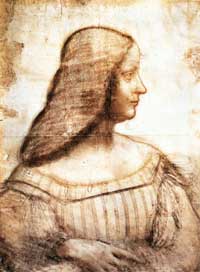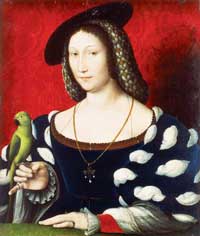Renaissance Women
The Renaissance made an epoch for women, through its appeal to beauty, its quick social developments, and the emotional energies that it involved. The Renaissance movement changed the role women had into society. They were no more "Queens of chivalry", they became companions.
It may be considered that, at the time, the women did for life what painting, sculpture, poetry had effected for beauty and ideas; they were its interpreters.
Among the Renaissance women, the personalities stood almost independent of their nationalities, with similar defects and qualities, and the same great interest in arts.
Women in Italy
The Italian women of the Renaissance period brought up large families, and they read Virgil, Cicero and Greek philosophy. They danced, they sang, and they commanded troops. They planned dresses, they wrote treatises, and they governed provinces.

Isabella d'Este
Musée du Louvre
Their education was the same as that of their brothers with whom they were sometimes brought up. Their religion was a matter of observance and etiquette. Vittoria Colonna, with her spiritual fervour, her persistent grief for her dead husband, her profound affection for Michelangelo, stands out in contrast to the rest of the important women of the Renaissance.
Giulia Gonzaga and the Venetian Veronica Gambara, were the busy goddesses of a daring intellectual coterie. Olympia Morata, at sixteen lectured in Ferrara on philosophy. She was a literary critic, and a skilfull translator of the Bible.
The Estes and Gonzagas gave the most complete types: Isabella d'Este, wife of Francesco Gonzaga, Duke of Mantua, was "the first lady of the world," as men called her. Isabella stood for the Renaissance Lady. Her sister-in-law, Elisabetta Gonzaga, wife of Duke Guidobaldo of Urbino, with her court full of writers, artists, and scholars, stood for what the Renaissance society meant. Beatrice d'Este, the wife of Ludovico Sforza, was as representative as her sister, besides her grace, her missals, jewels and painted clavichords.
A true Renaissance woman had a real enthusiasm for art, and Isabella, as a connoisseur and a collector, stands foremost among the extravagant, fastidious lovers of the beautiful. However, many times the common human instincts prevailed. Isabella's greatest enjoyment was to possess something her neighbours could not get. A fierce competition developed between Isabella and Lucrezia Borgia over their antiques, and all means were used to win. For example, to emulate her rival's finest piece, Lucrezia bought a modern "Cupid," which she exhibited as an old one.
At Urbino, the life and light of the court was Emilia Pia, known also as "Madonna Emilia", the sister-in-law of Elisabetta Gonzaga . She was the "maistresse and ringleader of all the companye so that every manne at her received understandinge and courage". As she lay dying, she recited passages from "Il Libro del Cortegiano", the famous work of Baldasare Castiglione, and a record of her happy prime.
Elisabetta Gonzaga, was more intellectual and more pensive. She was the immortal hostess of Castiglione's "Il Cortegiano", the living picture of the literary court of Guidobaldo, Duke of Urbino; the modern hostess, who effaces herself to draw out others, to fuse conflicting elements, to give zest and to restrain. She was helped by her husband, a delicate Stoic, crippled by gout at twenty. His illness throwing him upon intellectual interests and the pleasures of good talk, he did much to ripen the art of conversation and to make his circle what it was, the flower of civilized Italian society.
That circle was illumined by the scholarship of Bembo and by the thoughtful urbanity of Castiglione. Bibbiena talked his best for such an audience, and Aretino, unique as genius and as scamp, electrified it by his improvising. Every important man or woman in Italy, every traveller of distinction was happy to join the circle, among them, Giuliano de' Medici.
The little company was more significant than it appeared. It marked a new stage in the growth of social ideals and of the position of Renaissance women. Castiglione was saying: "With them we had such free and honest conversation that every manne might commune, sit daily and laugh with whom he had lusted. But such was the respect we bore to the Dutchess's will that the self-same liberty was a very great bridle."
Castiglione was the champion of women, and his book is perhaps the first self-conscious statement of their claims; of the age-old questions as to what woman should be, whether she should spin or think, what is her true relation to man. We also find that, besides these topics, there were others of lesser weight, like the fashioning of the perfect Courtier.
Renaissance Women in France
The protector of the French Renaissance was a woman, the sister of Francis I, Marguerite D'Angoulême, Queen of Navarre. Herself a force in literature, a poet, she seems to stand forth as the type of the multi-coloured contrasts of her day.

Marguerite D'Angoulême
She wrote the Heptameron, a volume of tales as bold as those of her model, Boccaccio's Decameron. She was the author of the abstruse "Mirror of a Sinful Soul" and of spiritual hymns. Artist and mystic, she was charged as heretic by the Sorbonne, yet she remained within the Church. She was a fighter, a reconciler, a scholarly woman, a correspondent and disciple of Erasmus. As a protector of the Renaissance movement, she helped everyone in need, among them Rabelais, Guillaume Budé (Budaeus), and Amyot.
The French women of the Renaissance, helping the arts even more than their Italian counterparts, showed one difference from these. They were eminently practical, with their learning and culture directed to some definite end.
The beauties of Catherine de' Medici's so-called "Flying Squadron" were a secret political agency working systematically through charm. Jeanne d'Albret, the daughter of Marguerite, was a Reformer and propagandist. Renée de France was also a supporter of the Reformation, and Calvin's pupil.
The influential Diane de Poitiers, the mistress of Henri II, had a strong personality. She was born a governess and an organizer. The Reine Margot, wife of Henri IV, a deep reader and a vivid autobiographer, was also a skilled politician. And Louise Labé, the poetess of Lyon, author of sonnets striking a note of natural passion very rare in her day, was an advanced feminist, who, according to some accounts, proved her courage at the siege of Perpignan.
Among the French Renaissance women, Marguerite d'Angoulême could have sincerely said that "she found it enough to exist."